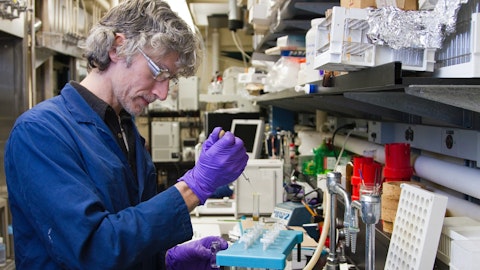Revolution Medicines, Inc. (NASDAQ:RVMD) Q3 2022 Earnings Call Transcript November 7, 2022
Revolution Medicines, Inc. misses on earnings expectations. Reported EPS is $-0.87 EPS, expectations were $-0.84.
Operator: Good day and thank you for standing by. Welcome to the Revolution Medicines Third Quarter 2022 Earnings Webcast. I would now like to hand the conference over to Peg Horn, Revolution Medicine’s Chief Operating Officer for opening remarks. Peg, you may begin.

Photo by Hans Reniers on Unsplash
Margaret Horn: Thank you and welcome, everyone, to our third-quarter earnings call. Joining me on today’s call are Dr. Mark Goldsmith, Revolution Medicine’s Chairman and Chief Executive Officer; Dr. Steve Kelsey, the company’s President, Research and Development; and Jack Anders, our Chief Financial Officer. As we begin, I would like to note that our presentation will include statements regarding the current beliefs of the company with respect to our business that constitutes forward-looking statements within the meaning of the Private Securities Litigation Reform Act. These statements are subject to a number of assumptions, risks and uncertainties. Actual results may differ materially from these statements. And except as required by law, the company undertakes no obligation to revise or update any forward-looking statements.
I encourage you to review the legal disclaimer slide of our corporate presentation or the earnings press release as well as all of the company’s filings with the SEC concerning these and other matters. With that, I will turn the call over to Dr. Mark Goldsmith, Revolution Medicines Chairman and Chief Executive Officer. Mark?
Mark Goldsmith: Good afternoon and thank you for joining us. Today, I’ll provide an update on our corporate progress and our Chief Financial Officer, Jack Anders, will provide highlights of our financial results. In the third quarter, Revolution Medicines continued advancing our pipeline of groundbreaking RAS(ON) inhibitors on behalf of patients with a wide range of RAS-addicted cancers which represent 30% of all human cancers. We are building momentum with our RAS(ON) inhibitor pipeline, having now advanced 2 RAS(ON) inhibitor development candidates into Phase I/Ib dose-escalation trials. With the transition of these RAS(ON) inhibitors into early clinical development, we now have 4 compounds from our cohesive portfolio of RAS cancer-targeted therapeutics in human studies.
This progress across our pipeline sets up an exciting and potentially data-rich 2023. I’ll now review a number of key achievements that reflect this recent progress regarding our pipeline of RAS(ON) inhibitors and RAS Companion inhibitors. First, we have entered the arena by advanced clinical development, the first 2 drug candidates from our highly innovative RAS(ON) inhibitor portfolio. In a Phase IIb trial, evaluating RMC-6236, our oral RAS multi-on inhibitor, investigators are dosing patients who have tumors harboring various common KRAS G12 cancer mutations which may include KRAS G12D, KRAS G12V and KRAS-G12R. We believe RMC-6236 is the first oral direct RAS(ON) inhibitor to be deployed against tumors harboring any of these prevalent RAS cancer drivers and marks a significant step in our effort to serve the unmet needs of patients with RAS-addicted cancers.
In a Phase I/Ib trial of our oral KRASG12C inhibitor, RMC-6291, investigators are dosing patients who have tumors harboring the KRAS G12C cancer variant. We have previously reported extensive preclinical data demonstrating the differentiated and promising antitumor profile of this highly selective covalent inhibitor of the activated or RAS(ON) state of the KRAS G12C variant found in lung and gastrointestinal cancers. RMC-6291 is the first of a series of mutant selective RAS(ON) inhibitors that we intend to bring into the clinic. Next up is our oral covalent inhibitor of KRAS G12D, the most common RAS cancer variant causing human cancer, RMC9805. IND-enabling work remains on track toward our goal of beginning clinical evaluation in mid-’23. This first wave of RAS(ON) inhibitor drug candidates, RMC-6236, 6291 and 9805 has the potential to help serve the vast majority of patients with RAS-addicted cancers.
And our portfolio contains additional RAS(ON) inhibitors lining that behind this first wave. In parallel, we continue a clinical evaluation of 2 class-leading RAS Companion inhibitors are shipped to inhibitor RMC-4630 and our into-selective inhibitor RMC-5552, both of which have one clinical numeral activity . These RAS Companion inhibitors are designed to be deployed primarily to the combination agents with direct RAS inhibitors. In the third quarter, our clinical collaborator, Amgen reported encouraging preliminary evidence from its Phase Ib CodeBreaK 101 clinical study, suggesting promising and durable benefit from combining RMC-4630 with Amgen’s KRAS G12C inhibitor, sotorasib, particularly in second-line treatment of patients with non-small cell lung cancer who were KRASG12C inhibitor naive.
We continue enrolling patients into our Phase II study of this combination, RMC-463003 in patients with KRAS G12C non-small cell lung cancer. Ultimately, we expect to evaluate our RAS companion inhibitors in combination with our own RAS(ON) inhibitors in the future. Now I’ll shift to our corporate progress and comment on our priorities for the remainder of 2023 of 2022 and 2023. In the quarter, we completed a follow-on equity financing, raising gross proceeds of $265 million to strengthen the company’s balance sheet and overall financial position to support the continued development and expansion of our product pipeline. With this strong financing behind us, we are focused on timely execution of the multiple development stage activities currently underway and our highest priority is to deliver on important clinical milestones in the coming year.
We continue deploying our development resources primarily in support of our 3 most advanced RAS(ON) inhibitors, RMC-6236, 6291 and 9805 and 2 clinical-stage RAS companion inhibitors, RMC-4630 and 5552. Despite this growing clinical pipeline, we continue our strong commitment to research activities that provide critical scientific insights to support ongoing development activities and that also leverage our proven RAS innovation engine to generate exciting new mutant selective RAS(ON) inhibitors with distinct profiles. We expect to nominate our next RAS(ON) inhibitor development candidate by the end of the year which will join a planned second wave of additional RAS(ON) inhibitor drug candidates, including our KRAS G13C inhibitor, ARMC-8839.
We anticipate advancing assets from this collection into development after 2023. With this R&D strategy supported by current cash, cash equivalents and marketable securities, extending operating runway through 2024, we are positioned to deliver on important milestones. In our RAS(ON) inhibitor portfolio upcoming milestones are as follows: to provide evidence of first-in-class single-agent activity for RMC-6236 in 2023, to provide preliminary evidence of superior activity for RMC-6291 in 2023 with this clinical profile potentially indicated by tolerability safety and/or antitumor effects and to announce dosing of the first patient in a monotherapy dose escalation study of ARMC-9805 in mid-’23. In our RAS Companion inhibitor portfolio, upcoming milestones are as follows: to provide top-line data from the 463003 study of RMC-4630 plus sotorasib in the second half of ’23 and to disclose additional evidence of single-agent activity for RMC-5552 in 2023.
In summary, we remain deeply committed to our science-driven approach to treating patients with RAS-addicted cancers and our development-stage pipeline and research efforts have entered an exciting and important phase. Our first wave of RAS(ON) inhibitors which includes 3 distinct and highly differentiated drug candidates has advanced significantly with patients now being dosed with RMC-6236 or 6291 and RMC-9805, continuing its progress towards the clinic. Our differentiated RAS Companion inhibitors RMC-4630 and 5552 have each shown evidence of single-agent clinical activity along the path towards strategic combinations with direct RAS inhibitors and initial clinical evidence has now emerged in support of RMC-4630 as a RAS Companion inhibitor used in combination with a direct RAS inhibitor.
As we intensify efforts to progress these assets to significant milestones in the coming period, we also continue to make a significant investment in pipeline expansion activities based on our productive RAS innovation engine. Building on the strong company momentum, I’ll now turn to Jack Anders, our Chief Financial Officer, to provide a financial update. Jack?
See also 11 Best Stocks To Buy for Deflation and 15 Most Innovative Countries in the World.
Jack Anders: Thank you, Mark. We strengthened our balance sheet in the quarter with the upsized public offering of common stock, raising gross proceeds of $265 million. Net proceeds were approximately $248 million, deducting , commissions and estimated offering expenses. Our ending cash and investment balance as of September 30, 2022, was $655 million which is expected to fund planned operations through 2024. Revenue from our collaboration agreement with Sanofi was $3.4 million in the third quarter of 2022 compared to $1.1 million in the prior year period. During the third quarter of 2022, the company recorded a non-cash GAAP accounting adjustment that reduced collaboration revenue by $4.6 million. This non-cash revenue adjustment was due to changes to the company’s estimates of the accounting transaction price and estimated percentage of completion of work performed to date under the agreement which resulted in a cumulative catch-up adjustment that reduced collaboration revenue.
We also had a similar catch-up adjustment related to revised estimates during the prior year quarter which reduced collaboration revenue by $8.5 million for that prior year period. Total operating expenses for the third quarter of 2022 were $79.9 million and increased by 47% over the prior year period. The increase in operating expenses was primarily driven by an increase in RMC-6236 and RMC-6291 costs as a result of commencing clinical trials during the year as well as an increase in personnel-related expenses related to additional headcount. Net loss for the third quarter of 2022 was $73.3 million or $0.87 per share. We are reiterating our financial guidance and continue to expect full-year 2022 GAAP net loss to be between $260 million and $280 million, with noncash stock-based compensation expense expected to be between $30 million and $35 million.
That concludes the financial update and I’ll now turn the call back over to Mark.
Mark Goldsmith: Thanks, Jack. Our goal at Revolution Medicines is to outsmart RAS-addicted cancers and we continue to show our tireless commitment to patients in pursuit of this goal. With recent scientific and business progress, we believe that the company is in an excellent position to fulfill our mission on behalf of cancer patients. This concludes our prepared remarks for today. And I’ll now turn the call over to the operator for the Q&A session. Operator?
Q&A Session
Follow Revolution Medicines Inc. (NASDAQ:RVMD)
Follow Revolution Medicines Inc. (NASDAQ:RVMD)
Operator: And our first question comes from Alec Stranahan with Bank of America.
Alec Stranahan: Just a couple from us. First on 6236, given there could be some overlap between the pan-RAS and the individual RAS inhibitors that you’re developing in terms of patients who could benefit. Curious just how you’re thinking about parallel development of these assets. And is the strategy just increasing shelf line goal? Or do you see discrete market opportunities either mono or combo for each of these assets? And then secondly, when you look at 5552, obviously, some interesting early activity here as monotherapy. But as you think about combination studies moving forward, are there particular drug partners or tumor types you think are more interesting to start with? Or is this really going to depend on the data update that we’ll see next year?
Mark Goldsmith: Thanks, Alex. Appreciate your question. Maybe I’ll comment on the first question and then perhaps Steve can comment on the second. So the first question is about RMC-6236 versus mutant selective inhibitors. At this stage, I think we don’t know enough to be able to say exactly which indications will best for most benefit from the multi-RAS inhibitor that hits multiple RAS variants, including wild-type versus the mutant selective inhibitor. We have some ideas about that but we’re really going to need to see what we learn in the clinic in order to guide that. Our guess is that it will depend on tissue type, other co-mutations and perhaps even stage of disease, that’s something we’ll just have to learn. So at this point, we’re in dose escalation, we’ll figure out the optimal way to dose each of these compounds and then we’ll begin to see where the activity is and what the limitations are on each.
Ultimately, we might see these put together in combinations anyway. It may be that RMC-6236 combined with 6291 is the most effective way to preempt emergence of resistance mutations and the same could apply for 9805 and other RAS selective inhibitors. It’s just too early to tell at this point and we’ll play out all of these. And as I said, our guess is that there will be certain circumstances in which one particular paradigm might apply more completely than another paradigm we shall see. Second question is RMC-5552. Steve?
Steve Kelsey: The primary focus of the single-agent dose escalation program that we’ve been running with RMC-5552 so far was really to assess whether or not we have a drug here that is worthy of further development in combination with our RAS Companion inhibitor. I think we’ve so far demonstrated clearly that it is. We have shown ON timely toxicity . We have PK exposures that are within the range that are consistent with activity in the precolomodils and we have efficacy. So we’re fairly confident that this is worth taking forward the RAS(ON) inhibitors. There are really 2 classes of co-mutation that occur in combination with RAS mutations that are probably going to be the initial focus of the development for RMC-5552. There are co-mutations where the mTOR signaling pathway is directly affected, the ones the most color there, obviously, 10 loss , PR3-kinase mutation, a couple of rare mutations perhaps in mTOR itself.
And then, there are the other class mutations which are probably more familiar to you, that tangentially seem to impact mTOR halfway signaling and those particularly STKLM and keep 1. And we have plenty of preclinical data now that RMC-5552 can act very favorably in combination with our RAS(ON) inhibitors to really turn around tumor regressions in tumors that co-express keep 1 mutations and STK mutations. As you know, the P1 co-mutant GMOs , these lung tumors do not do so well with single-agent basis, at least the first generation RAS(ON) inhibitors. So that’s a fair — it’s a fairly linear development path for RMC-5552, Ultimately, down the road, maybe other things we could do with that compound but the initial focus is the co-mutants. There are a lot of them.





